check engine light lexus LC500 2020 Owner's Manual / LEXUS 2020 LC500,LC500H OWNER'S MANUAL (OM11537U)
[x] Cancel search | Manufacturer: LEXUS, Model Year: 2020, Model line: LC500, Model: Lexus LC500 2020Pages: 436, PDF Size: 13.86 MB
Page 4 of 436
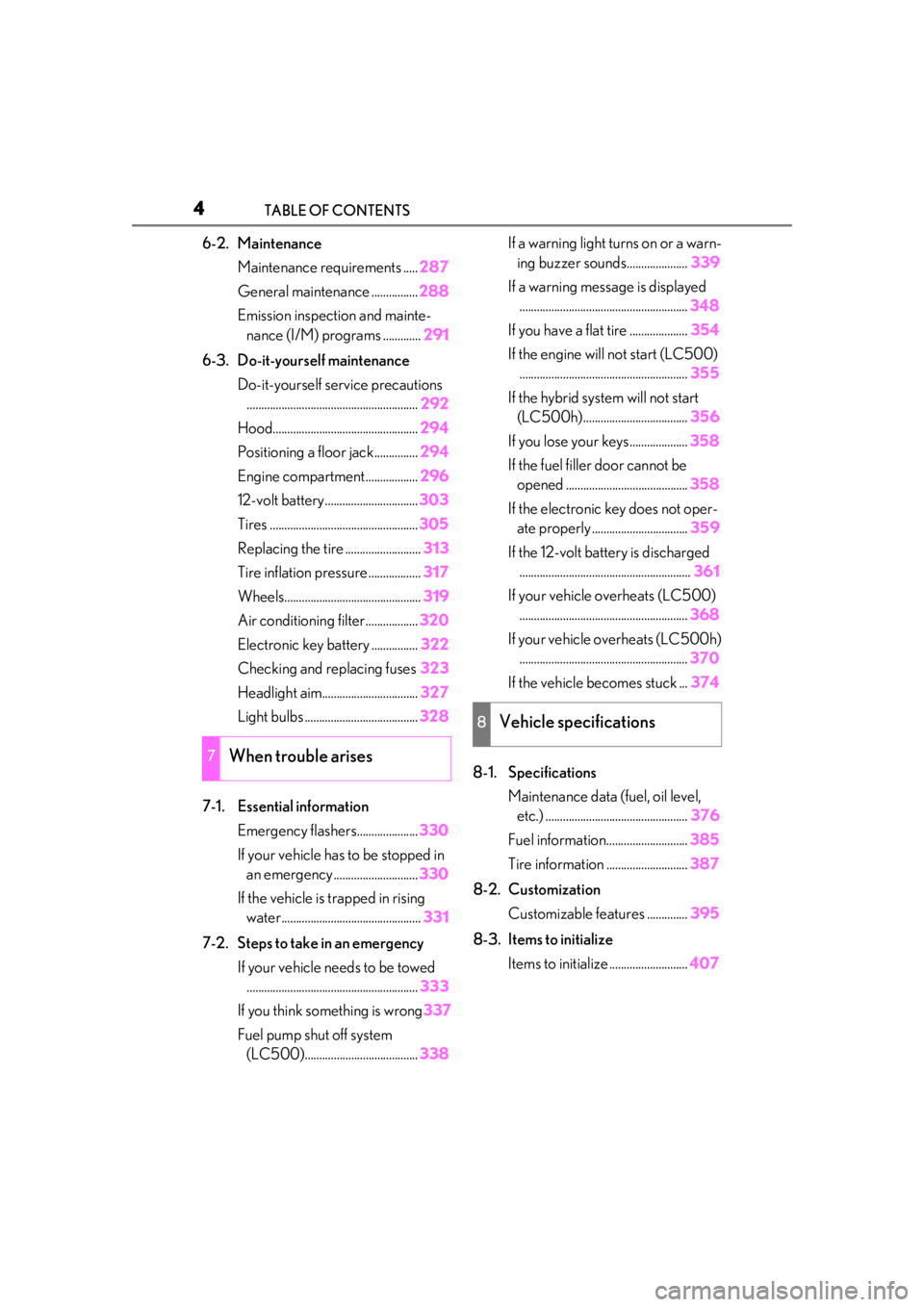
4TABLE OF CONTENTS
6-2. MaintenanceMaintenance requirements ..... 287
General maintenance ................ 288
Emission inspection and mainte- nance (I/M) programs ............. 291
6-3. Do-it-yourself maintenance Do-it-yourself service precautions........................................................... 292
Hood.................................................. 294
Positioning a floor jack............... 294
Engine compartment.................. 296
12-volt battery................................ 303
Tires ................................................... 305
Replacing the tire .......................... 313
Tire inflation pressure .................. 317
Wheels............................................... 319
Air conditioning filter..................320
Electronic key battery ................ 322
Checking and replacing fuses 323
Headlight aim................................. 327
Light bulbs ....................................... 328
7-1. Essential information Emergency flashers..................... 330
If your vehicle has to be stopped in an emergency ............................. 330
If the vehicle is trapped in rising water................................................ 331
7-2. Steps to take in an emergency If your vehicle needs to be towed........................................................... 333
If you think something is wrong 337
Fuel pump shut off system (LC500)....................................... 338If a warning light turns on or a warn-
ing buzzer sounds..................... 339
If a warning messa ge is displayed
.......................................................... 348
If you have a flat tire .................... 354
If the engine will not start (LC500) .......................................................... 355
If the hybrid syst em will not start
(LC500h).................................... 356
If you lose your keys.................... 358
If the fuel filler door cannot be opened .......................................... 358
If the electronic key does not oper- ate properly ................................. 359
If the 12-volt battery is discharged ........................................................... 361
If your vehicle overheats (LC500) .......................................................... 368
If your vehicle overheats (LC500h) .......................................................... 370
If the vehicle becomes stuck ... 374
8-1. Specifications Maintenance data (fuel, oil level, etc.) ................................................. 376
Fuel information............................ 385
Tire information ............................ 387
8-2. Customization Customizable features .............. 395
8-3. Ite
ms to initialize
Items to initialize ........................... 407
7When trouble arises
8Vehicle specifications
Page 13 of 436
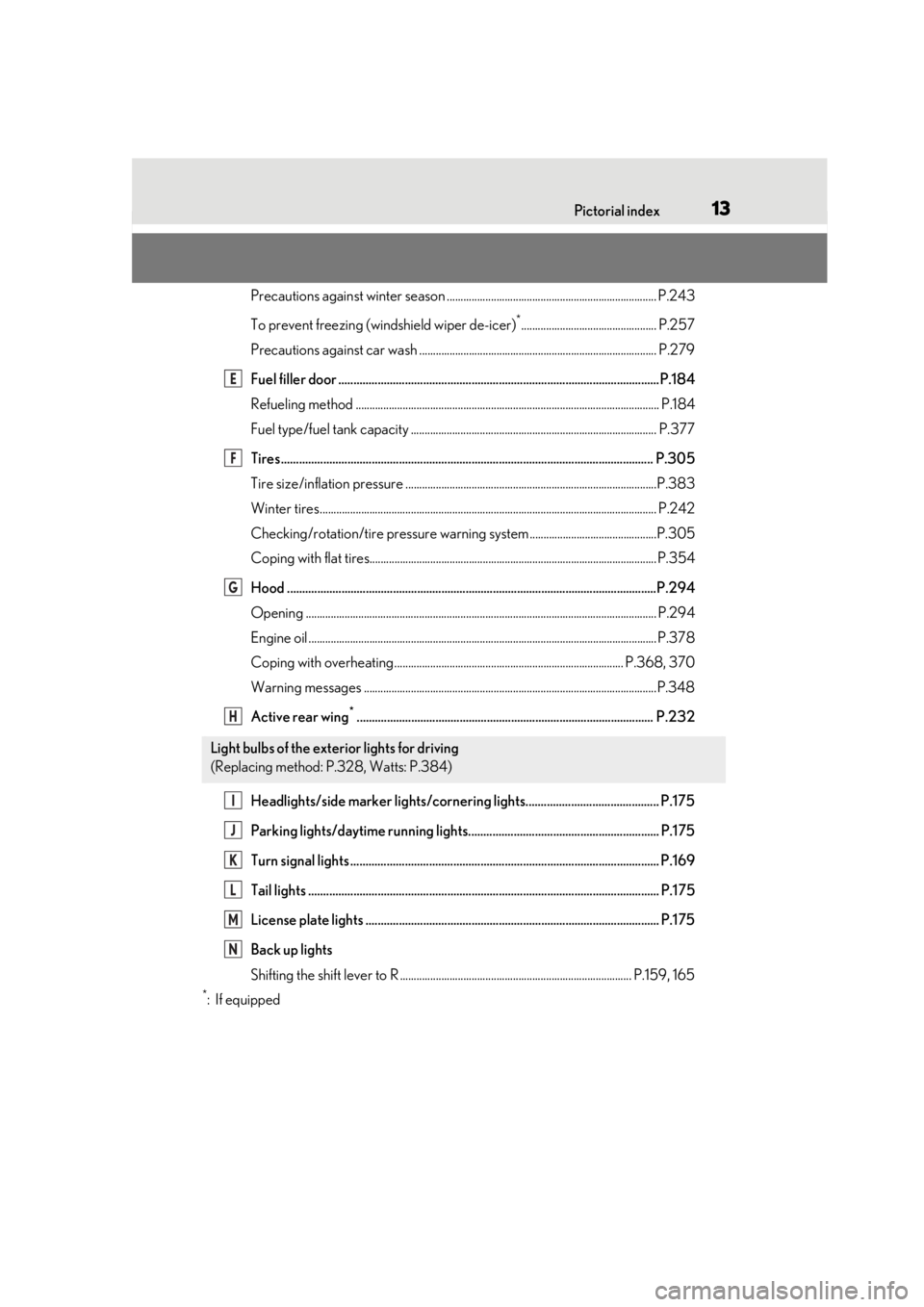
13Pictorial index
Precautions against winter season ............................................................................ P.243
To prevent freezing (windshield wiper de-icer)
*................................................. P.257
Precautions against car wash ...................................................................................... P.279
Fuel filler door ..........................................................................................................P.184
Refueling method .............................................................................................................. P .184
Fuel type/fuel tank capacity ...... ................................................................................... P.377
Tires.......................................................................................................................... .P.305
Tire size/inflation pressure ............................ ...............................................................P.383
Winter tires.......................................................................................................................... P.242
Checking/rotation/tire pressure warning system..............................................P.305
Coping with flat tires........................................................................................................ P .354
Hood ..........................................................................................................................P.294
Opening ............................................................................................................................... P.294
Engine oil ..................................................................................................................... ......... P.378
Coping with overheating ................................................................................... P.368, 370
Warning messages ..........................................................................................................P.348
Active rear wing
*.................................................................................................. P.232
Headlights/side marker lights/cornering lights............................................ P.175
Parking lights/daytime running lights............................................................... P.175
Turn signal lights ...................................................................................................... P.169
Tail lights .................................................................................................................... P.175
License plate lights ................................................................................................. P.175
Back up lights
Shifting the shift lever to R .................................................................................... P.159, 165
*:If equipped
Light bulbs of the exterior lights for driving
(Replacing method: P.328, Watts: P.384)
E
F
G
H
I
J
K
L
M
N
Page 42 of 436
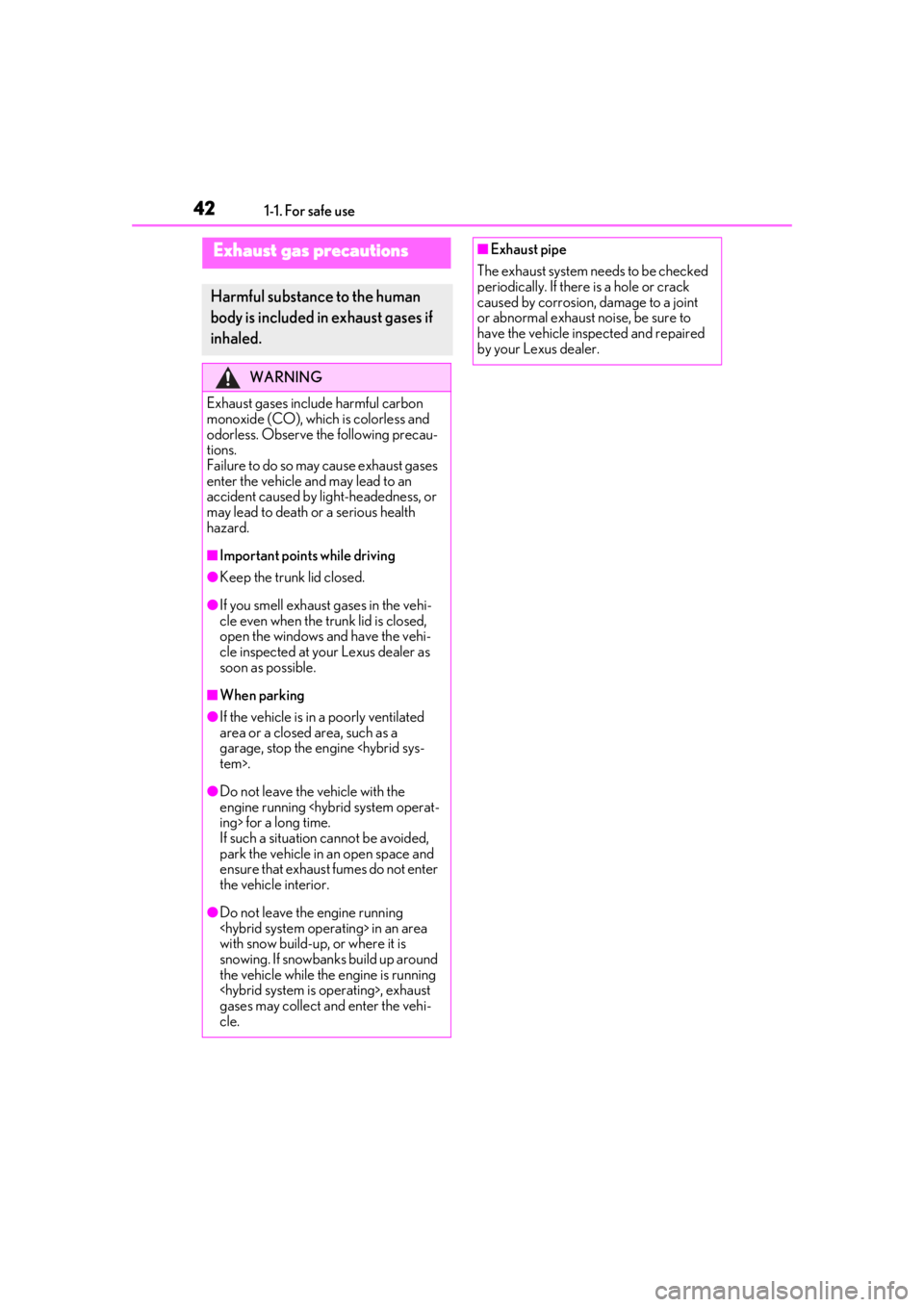
421-1. For safe use
Exhaust gas precautions
Harmful substance to the human
body is included in exhaust gases if
inhaled.
WARNING
Exhaust gases include harmful carbon
monoxide (CO), which is colorless and
odorless. Observe the following precau-
tions.
Failure to do so may cause exhaust gases
enter the vehicle and may lead to an
accident caused by light-headedness, or
may lead to death or a serious health
hazard.
■Important points while driving
●Keep the trunk lid closed.
●If you smell exhaust gases in the vehi-
cle even when the trunk lid is closed,
open the windows and have the vehi-
cle inspected at your Lexus dealer as
soon as possible.
■When parking
●If the vehicle is in a poorly ventilated
area or a closed area, such as a
garage, stop the engine
●Do not leave the vehicle with the
engine running
If such a situation cannot be avoided,
park the vehicle in an open space and
ensure that exhaust fumes do not enter
the vehicle interior.
●Do not leave the engine running
with snow build-up, or where it is
snowing. If snowbanks build up around
the vehicle while the engine is running
gases may collect and enter the vehi-
cle.
■Exhaust pipe
The exhaust system needs to be checked
periodically. If there is a hole or crack
caused by corrosion, damage to a joint
or abnormal exhaust noise, be sure to
have the vehicle inspected and repaired
by your Lexus dealer.
Page 70 of 436
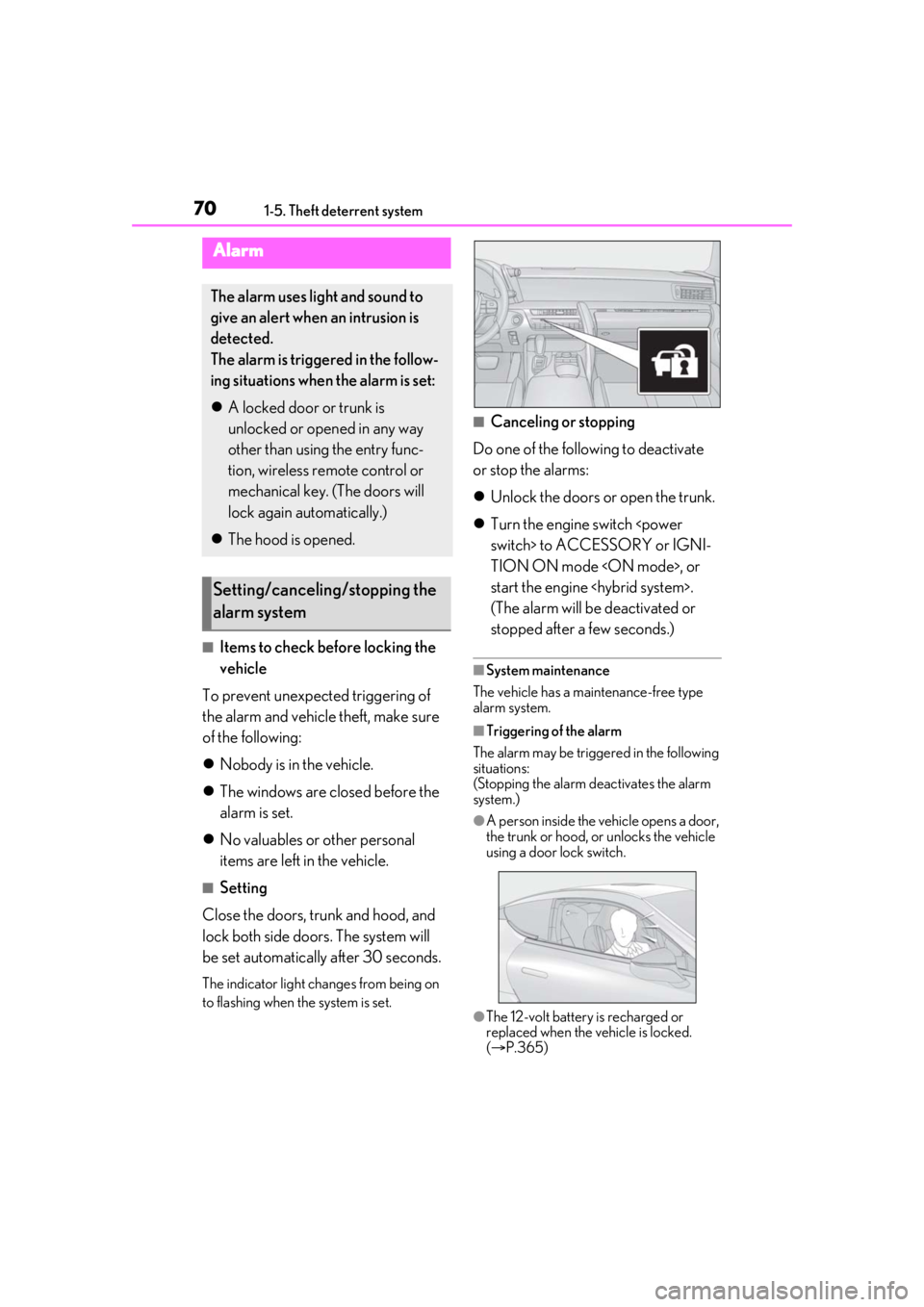
701-5. Theft deterrent system
■Items to check before locking the
vehicle
To prevent unexpected triggering of
the alarm and vehicle theft, make sure
of the following:
Nobody is in the vehicle.
The windows are closed before the
alarm is set.
No valuables or other personal
items are left in the vehicle.
■Setting
Close the doors, trunk and hood, and
lock both side doors. The system will
be set automatically after 30 seconds.
The indicator light changes from being on
to flashing when the system is set.
■Canceling or stopping
Do one of the following to deactivate
or stop the alarms:
Unlock the doors or open the trunk.
Turn the engine switch
TION ON mode
start the engine
(The alarm will be deactivated or
stopped after a few seconds.)
■System maintenance
The vehicle has a maintenance-free type
alarm system.
■Triggering of the alarm
The alarm may be triggered in the following
situations:
(Stopping the alarm deactivates the alarm
system.)
●A person inside the vehicle opens a door,
the trunk or hood, or unlocks the vehicle
using a door lock switch.
●The 12-volt battery is recharged or
replaced when the vehicle is locked.
( P.365)
Alarm
The alarm uses light and sound to
give an alert when an intrusion is
detected.
The alarm is triggered in the follow-
ing situations when the alarm is set:
A locked door or trunk is
unlocked or opened in any way
other than using the entry func-
tion, wireless remote control or
mechanical key. (The doors will
lock again automatically.)
The hood is opened.
Setting/canceling/stopping the
alarm system
Page 75 of 436

752-1. Instrument cluster
2
Vehicle status information and indicators
Warning lights inform the driver of mal-
functions in the indicated vehicle sys-
tems.
*1: These lights turn on when the engine switch
IGNITION ON mode
indicate that a system check is being
performed. They will turn off after the
engine
Warning lights
(U.S.A.)
Brake system warning light*1
( P.339)
(red)
(Canada)
Brake system warning light*1
( P.339)
Charging system warning
light
*2 ( P.339)
Low engine oil pressure
warning light
*2 ( P.339)
(U.S.A.)
Malfunction indicator lamp*1
( P.340)
(Canada)
Malfunction indicator lamp*1
( P.340)
SRS warning light
*1
( P.340)
(U.S.A.)
ABS warning light*1
( P.340)
(Canada)
ABS warning light*1
( P.340)
(red)
Electric power steering sys-
tem warning light
*1 ( P.340)
(yellow)
Electric power steering sys-
tem warning light
*1 ( P.340)
PCS warning light
*1, 3
( P.341)
(orange)
LKA indicator*2 ( P.341)
Slip indicator*1 ( P.341)
Brake Override System
warning light
( P.342)/Drive-Start Con-
trol warning light
*2 ( P.342)
Brake hold operated indica-
tor
*1, 3 ( P.342)
(U.S.A.)
Parking brake indicator*3
( P.342)
(Canada)
Parking brake indicator*3
( P.342)
(yellow)
Brake system warning light*1
( P.343)
Low fuel level warning light
( P.343)
Driver’s and front passen-
ger’s seat belt reminder light
( P.343)
Rear passengers’ seat belt
reminder lights
*4 ( P.344)
Master warning light
*1
( P.344)
Tire pressure warning light
*1, 3
( P.344)
High coolant temperature
warning light
*2 ( P.344)
(if equipped)
Hybrid system overheat
warning light
*2( P.345)
Page 77 of 436
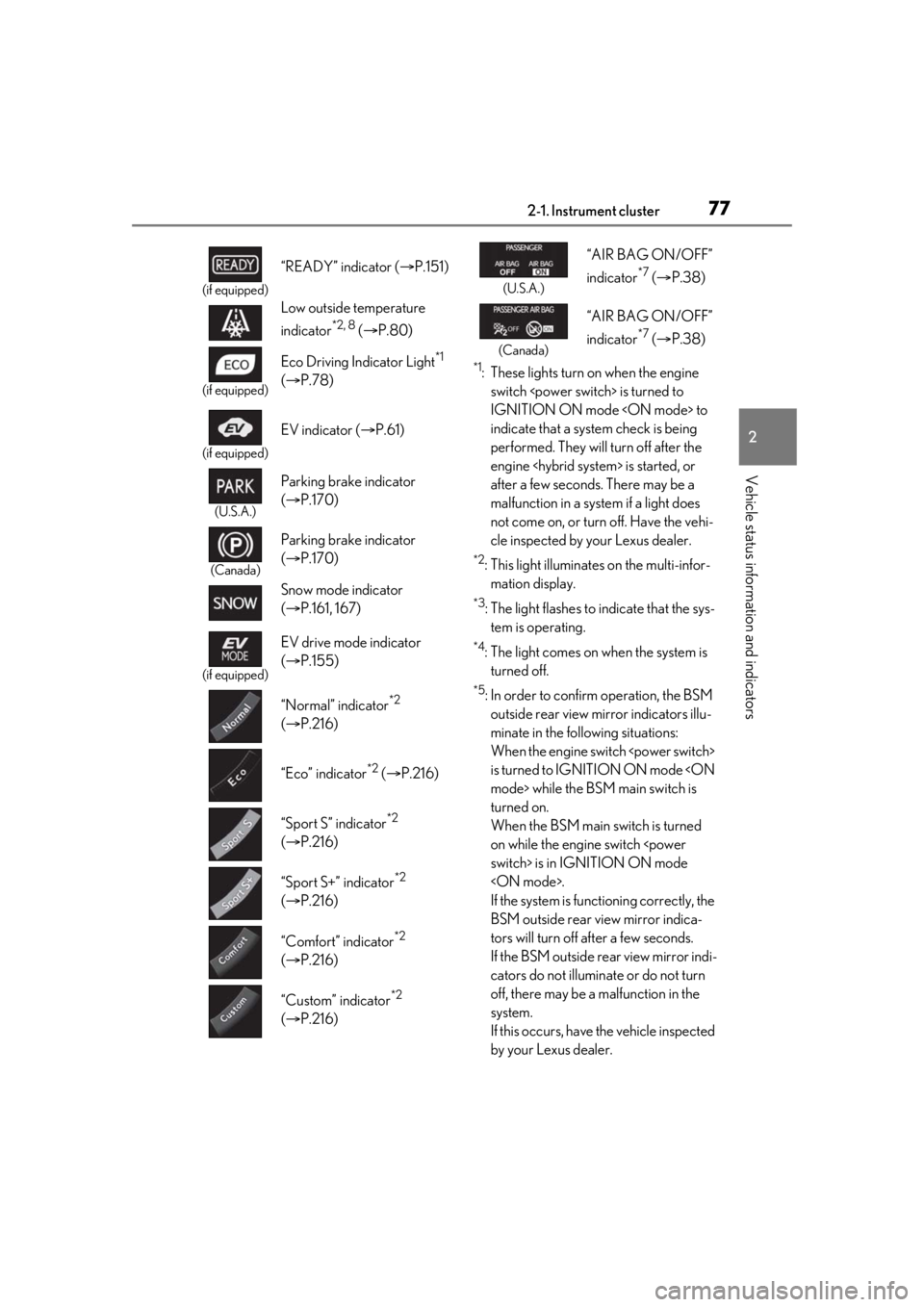
772-1. Instrument cluster
2
Vehicle status information and indicators
*1: These lights turn on when the engine switch
IGNITION ON mode
indicate that a system check is being
performed. They will turn off after the
engine
after a few seconds. There may be a
malfunction in a syst em if a light does
not come on, or turn off. Have the vehi-
cle inspected by your Lexus dealer.
*2: This light illuminates on the multi-infor- mation display.
*3: The light flashes to indicate that the sys-tem is operating.
*4: The light comes on when the system is turned off.
*5: In order to confirm operation, the BSM outside rear view mirror indicators illu-
minate in the following situations:
When the engine switch
is turned to IGNITION ON mode
turned on.
When the BSM main switch is turned
on while the engine switch
If the system is func tioning correctly, the
BSM outside rear view mirror indica-
tors will turn off after a few seconds.
If the BSM outside rear view mirror indi-
cators do not illuminate or do not turn
off, there may be a malfunction in the
system.
If this occurs, have the vehicle inspected
by your Lexus dealer.
(if equipped)
“READY” indicator ( P.151)
Low outside temperature
indicator
*2, 8 ( P.80)
(if equipped)
Eco Driving Indicator Light*1
( P.78)
(if equipped)
EV indicator ( P.61)
(U.S.A.)
Parking brake indicator
( P.170)
(Canada)
Parking brake indicator
( P.170)
Snow mode indicator
( P.161, 167)
(if equipped)
EV drive mode indicator
( P.155)
“Normal” indicator
*2
( P.216)
“Eco” indicator
*2 ( P.216)
“Sport S” indicator
*2
( P.216)
“Sport S+” indicator
*2
( P.216)
“Comfort” indicator
*2
( P.216)
“Custom” indicator
*2
( P.216)
(U.S.A.)
“AIR BAG ON/OFF”
indicator
*7 ( P.38)
(Canada)
“AIR BAG ON/OFF”
indicator
*7 ( P.38)
Page 83 of 436
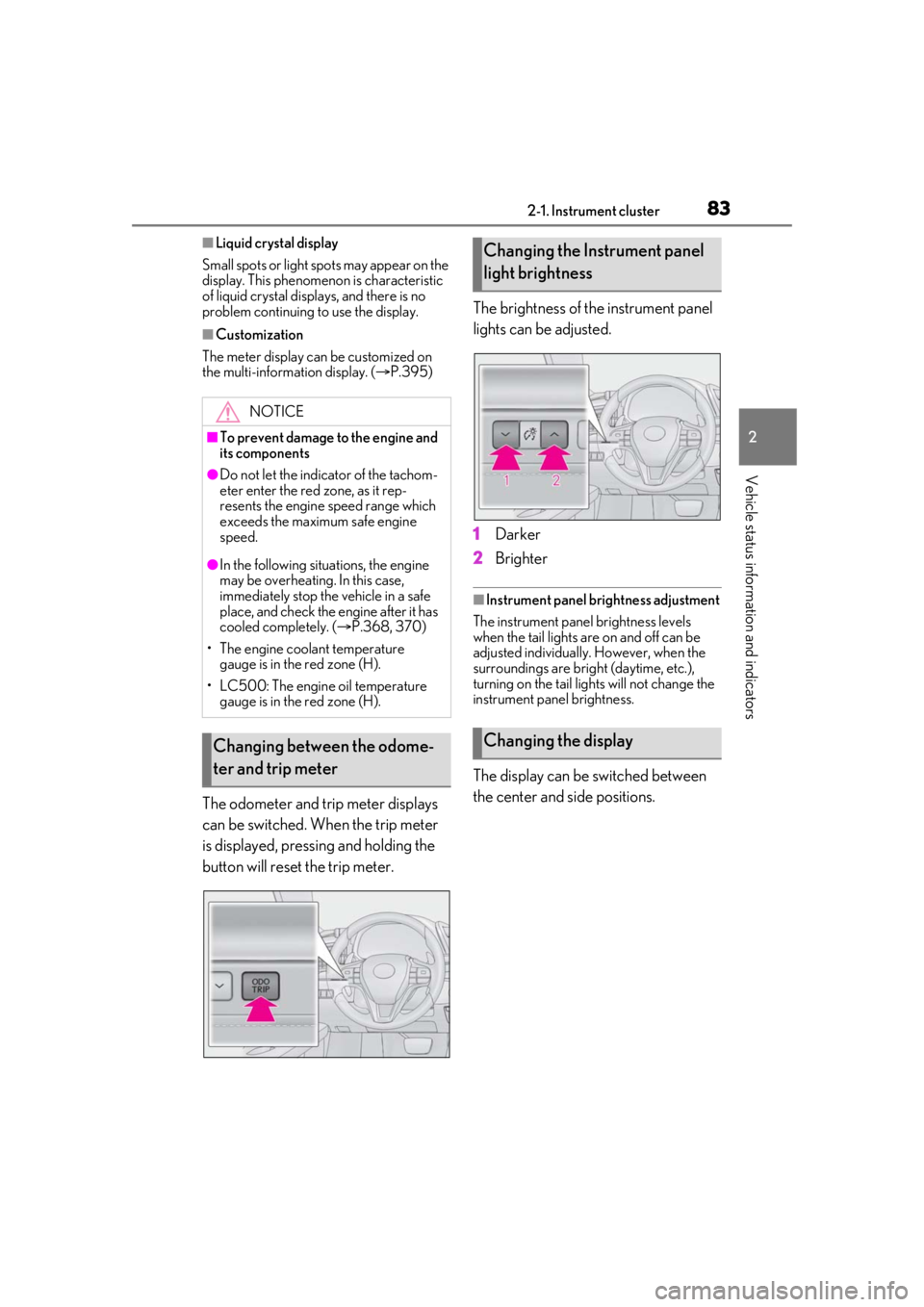
832-1. Instrument cluster
2
Vehicle status information and indicators
■Liquid crystal display
Small spots or light spots may appear on the
display. This phenomenon is characteristic
of liquid crystal displays, and there is no
problem continuing to use the display.
■Customization
The meter display can be customized on
the multi-information display. ( P.395)
The odometer and trip meter displays
can be switched. When the trip meter
is displayed, pressing and holding the
button will reset the trip meter. The brightness of the instrument panel
lights can be adjusted.
1
Darker
2 Brighter
■Instrument panel brightness adjustment
The instrument panel brightness levels
when the tail lights are on and off can be
adjusted individually. However, when the
surroundings are bright (daytime, etc.),
turning on the tail lights will not change the
instrument pa nel brightness.
The display can be switched between
the center and side positions.
NOTICE
■To prevent damage to the engine and
its components
●Do not let the indicator of the tachom-
eter enter the red zone, as it rep-
resents the engine speed range which
exceeds the maximum safe engine
speed.
●In the following situations, the engine
may be overheating. In this case,
immediately stop the vehicle in a safe
place, and check the engine after it has
cooled completely. ( P.368, 370)
• The engine coolant temperature gauge is in the red zone (H).
• LC500: The engine oil temperature gauge is in the red zone (H).
Changing between the odome-
ter and trip meter
Changing the Instrument panel
light brightness
Changing the display
Page 125 of 436
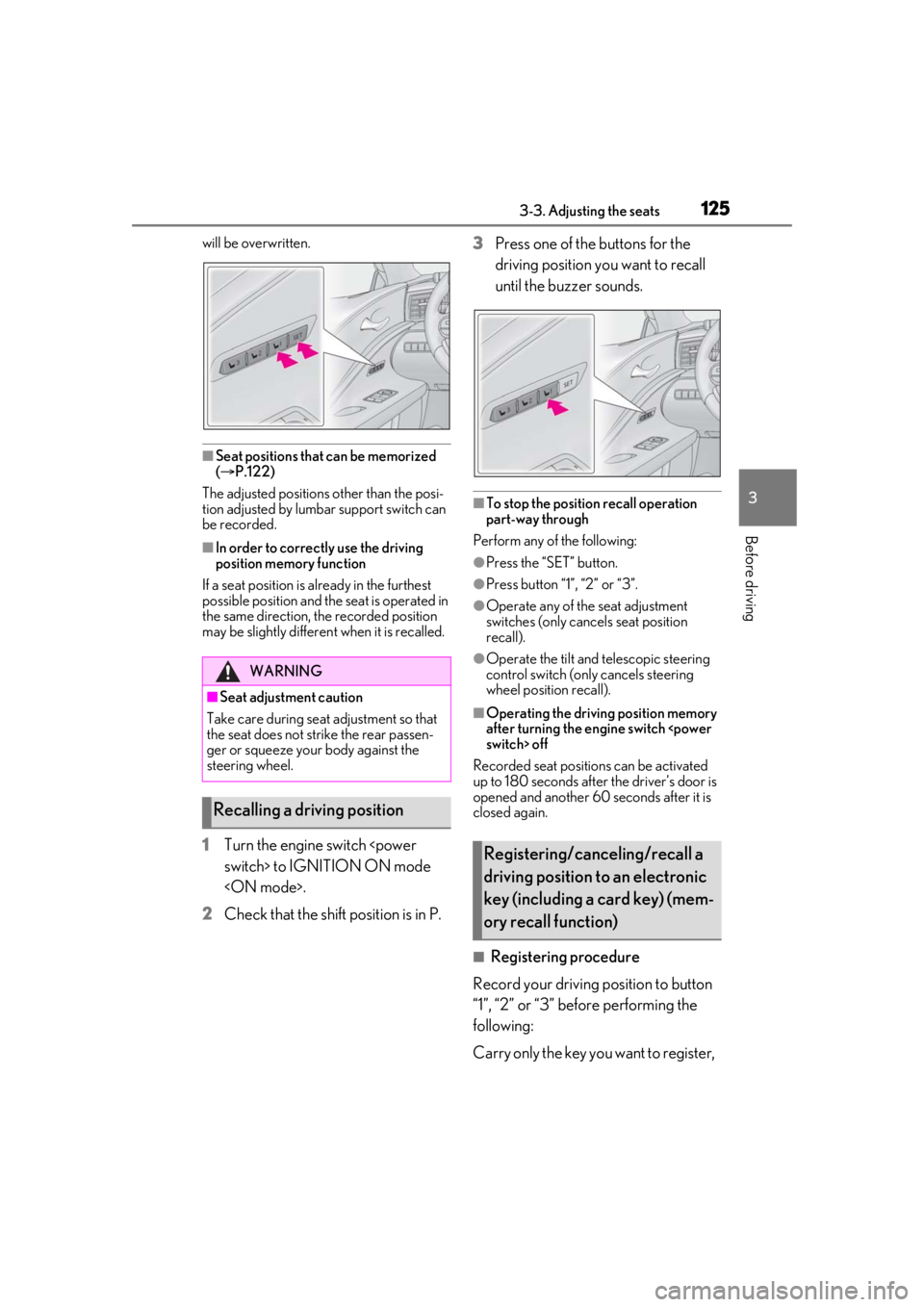
1253-3. Adjusting the seats
3
Before driving
will be overwritten.
■Seat positions that can be memorized
( P.122)
The adjusted positions other than the posi-
tion adjusted by lumbar support switch can
be recorded.
■In order to correctly use the driving
position memory function
If a seat position is already in the furthest
possible position and the seat is operated in
the same direction, the recorded position
may be slightly differen t when it is recalled.
1Turn the engine switch
2 Check that the shift position is in P. 3
Press one of the buttons for the
driving position you want to recall
until the buzzer sounds.
■To stop the position recall operation
part-way through
Perform any of the following:
●Press the “SET” button.
●Press button “1”, “2” or “3”.
●Operate any of the seat adjustment
switches (only cancels seat position
recall).
●Operate the tilt and telescopic steering
control switch (onl y cancels steering
wheel position recall).
■Operating the driving position memory
after turning the engine switch
Recorded seat positions can be activated
up to 180 seconds after the driver’s door is
opened and another 60 seconds after it is
closed again.
■Registering procedure
Record your driving position to button
“1”, “2” or “3” before performing the
following:
Carry only the key yo u want to register,
WARNING
■Seat adjustment caution
Take care during seat adjustment so that
the seat does not strike the rear passen-
ger or squeeze your body against the
steering wheel.
Recalling a driving position
Registering/canceling/recall a
driving position to an electronic
key (including a card key) (mem-
ory recall function)
Page 140 of 436
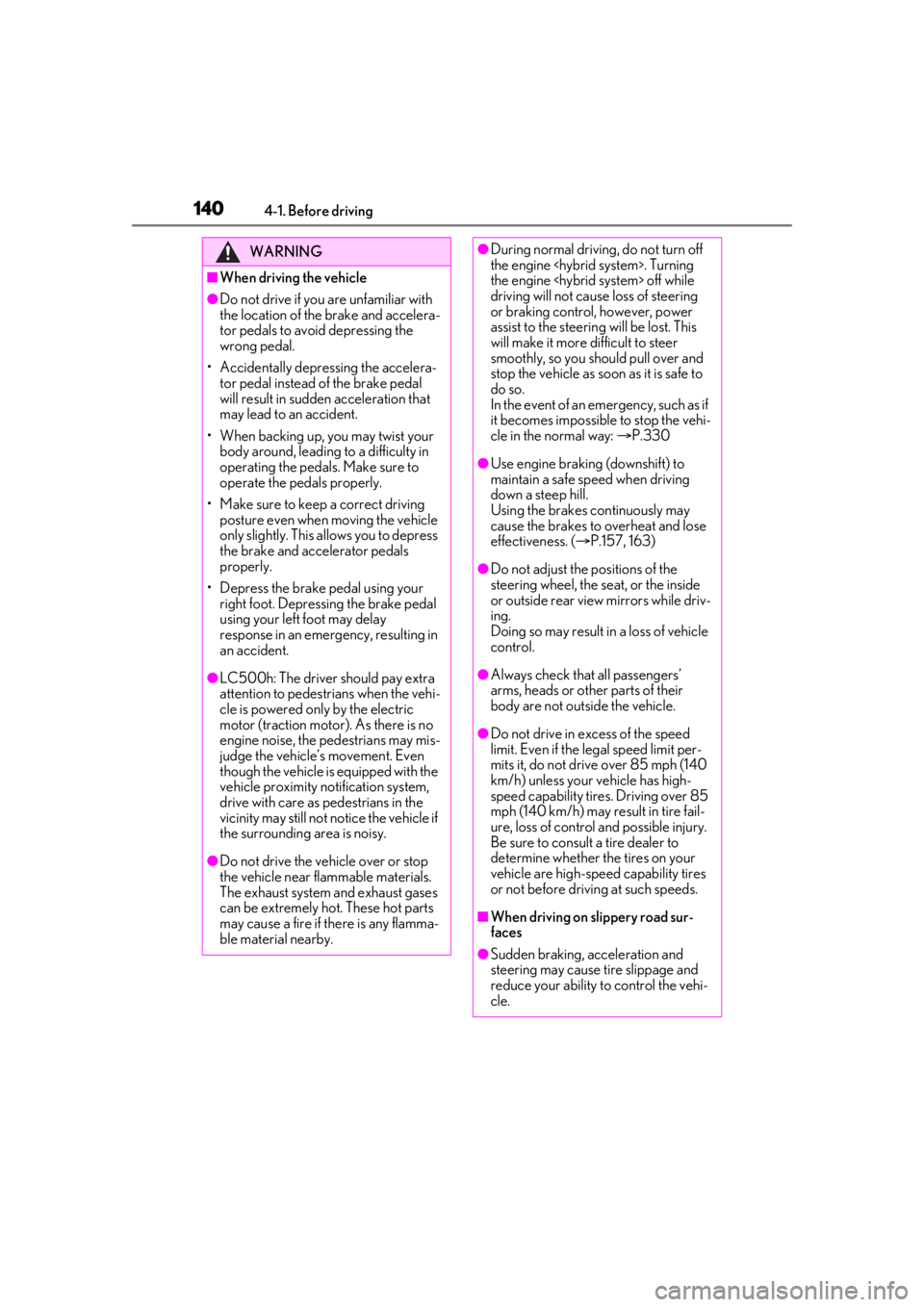
1404-1. Before driving
WARNING
■When driving the vehicle
●Do not drive if you are unfamiliar with
the location of the brake and accelera-
tor pedals to avoid depressing the
wrong pedal.
• Accidentally depressing the accelera- tor pedal instead of the brake pedal
will result in sudden acceleration that
may lead to an accident.
• When backing up, you may twist your body around, leading to a difficulty in
operating the pedals. Make sure to
operate the pedals properly.
• Make sure to keep a correct driving posture even when moving the vehicle
only slightly. This allows you to depress
the brake and accelerator pedals
properly.
• Depress the brake pedal using your right foot. Depressing the brake pedal
using your left foot may delay
response in an emergency, resulting in
an accident.
●LC500h: The driver should pay extra
attention to pedestrians when the vehi-
cle is powered only by the electric
motor (traction motor). As there is no
engine noise, the pedestrians may mis-
judge the vehicle’s movement. Even
though the vehicle is equipped with the
vehicle proximity notification system,
drive with care as pedestrians in the
vicinity may still not notice the vehicle if
the surrounding area is noisy.
●Do not drive the vehicle over or stop
the vehicle near flammable materials.
The exhaust system and exhaust gases
can be extremely hot. These hot parts
may cause a fire if there is any flamma-
ble material nearby.
●During normal driving, do not turn off
the engine
the engine
driving will not cause loss of steering
or braking control, however, power
assist to the steering will be lost. This
will make it more difficult to steer
smoothly, so you should pull over and
stop the vehicle as soon as it is safe to
do so.
In the event of an emergency, such as if
it becomes impossible to stop the vehi-
cle in the normal way: P.330
●Use engine braking (downshift) to
maintain a safe speed when driving
down a steep hill.
Using the brakes continuously may
cause the brakes to overheat and lose
effectiveness. ( P.157, 163)
●Do not adjust the positions of the
steering wheel, the seat, or the inside
or outside rear view mirrors while driv-
ing.
Doing so may result in a loss of vehicle
control.
●Always check that all passengers’
arms, heads or other parts of their
body are not outside the vehicle.
●Do not drive in excess of the speed
limit. Even if the legal speed limit per-
mits it, do not drive over 85 mph (140
km/h) unless your vehicle has high-
speed capability tires. Driving over 85
mph (140 km/h) may re sult in tire fail-
ure, loss of control and possible injury.
Be sure to consult a tire dealer to
determine whether the tires on your
vehicle are high-speed capability tires
or not before driving at such speeds.
■When driving on slippery road sur-
faces
●Sudden braking, acceleration and
steering may cause tire slippage and
reduce your ability to control the vehi-
cle.
Page 141 of 436

1414-1. Before driving
4
Driving
WARNING
●Sudden acceleration, engine braking
due to shifting, or changes in engine
speed could cause the vehicle to skid,
resulting in an accident.
●After driving through a puddle, lightly
depress the brake pedal to make sure
that the brakes are functioning prop-
erly. Wet brake pads may prevent the
brakes from functioning properly. If the
brakes on only one side are wet and
not functioning properly, steering con-
trol may be affected.
■When shifting the shift position
●LC500: Do not let the vehicle roll
backward while a forward driving posi-
tion is selected, or roll forward while
the shift position is in R.
Doing so may cause the engine to stall
or lead to poor brake and steering
performance, resulting in an accident
or damage to the vehicle.
LC500h: Do not let the vehicle roll
backward while a forward driving posi-
tion is selected, or roll forward while
the shift position is in R.
Doing so may result in an accident or
damage to the vehicle.
●Do not shift the shift position to P while
the vehicle is moving.
Doing so can damage the transmission
and may result in a loss of vehicle con-
trol.
●Do not shift the shift position to R while
the vehicle is moving forward.
Doing so can damage the transmission
and may result in a loss of vehicle con-
trol.
●Do not shift the shift position to a driv-
ing position while the vehicle is moving
backward.
Doing so can damage the transmission
and may result in a loss of vehicle con-
trol.
●LC500: Changing the shift position to
N while the vehicle is moving will dis-
engage the engine from the transmis-
sion. Engine braking is not available
when N is selected.
LC500h: Changing the shift position
to N while the vehicle is moving will
disengage the hybrid system. Engine
braking is not available with the hybrid
system disengaged.
●Be careful not to change the shift posi-
tion with the accelerator pedal
depressed. Changing the shift posi-
tion to any positions other than P or N
may lead to unexpected rapid acceler-
ation of the vehicle that may cause an
accident and result in death or serious
injury.
After changing the shift position, make
sure to confirm the current shift posi-
tion displayed on the shift position indi-
cator inside the meter.
■Brake pad wear
If any of the following situations occurs,
have the brake pads visually checked and
replaced by your Lexus dealer as soon as
possible.
●If the thickness of the brake pads
exceeds the brake pad wear limit when
visually checking all four brake pads
(for the brake pad wear limit, refer to
P.382)
●If “Brake Pad Wear Visit Your Dealer”
is displayed (only the right-side pads
can be detected)
Rotor damage may result if the pads are
not replaced when needed. Moderate
levels of the brake pad and disc wear
allow enhanced braking power. As a
result, the discs may wear more quickly
than conventional brake discs. Therefore,
when replacing the brake pads, Lexus
recommends that you also have the
thickness of the discs measured. It is dan-
gerous to drive the vehicle when the
wear limits of the brake pads and/or
those of the brake discs are exceeded.